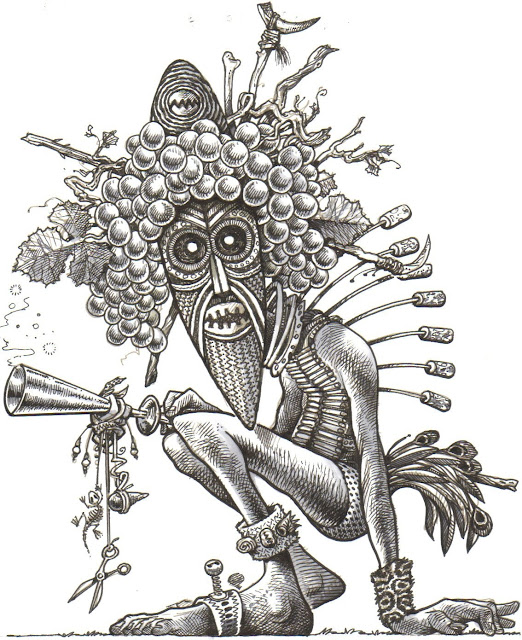$25; 13.5% alcohol; screw cap; tasted 30 October – 2 November 2011; 94++ points
A complex, surprising, yet beautifully assimilated wine, this seems to tease you with comforting, creamy-fruit aromas, concentrate these with flavour, and then gradually ease off, leaving the palate cleansed and puckering. In three vintages, we can see this young vineyard very quickly getting its roots into the ironstone, sand, and riverine galets of its site. This latter stuff, in loose alluvium from the range across the faultline, is very similar to the Rhone sites where Roussanne works best. The wine has the shape of a grand Burgundy of good natural acidity, yet with a completely different set of flavours. This seems based around the custard apple and the star fruit, and creams derived from these, along with the buttery Rocha pear. Then comes the ginger and lemon juice, then pith and the cantaloupe peel, and then those pale dusty tannins. It is at once satisfying yet appetizing, and makes me immediately think of lunch at Fino. Beautiful. I should confess here: I rent a small flat on the Yangarra property. Quite deliberately. Imagine having stuff like this growing where your front lawn would normally be.
Admission: this fruit grew just over the horse paddock from my residence, in a tiny vineyard that I walk in, so I have a deep paternal hope that the wine's good. And it is, if its cultish reputation around the best restaurants of McLaren Vale is any measure. At the impeccable Fino in Willunga, Sharon Romero sells stacks; Tony Bilson keeps reordering for his lists in Sydney's Radisson and his speccy new wine bar, Number 1, on the Circular Quay plaza on the Harbour. I've been postponing the review writing, because I wasn't completely certain how this wine would age, and while it seemed from the start it would do so very well, it's a new product and I wanted to watch it for some months. Paternally, see. Which is what's happened to this poor bottle: it's been opened, then rescrewed, and left, one third full, in my fridge for three weeks. It's still fresh and totally disarming, with a shy edge of old ginger-and-nutmeg oak, but with an acrid, freshly-chipped ironstone blade, perfectly reflecting the rock beneath the old cabernet roots it was grafted to some years ago. If it's developed anything after all that air, it's honeysuckle. Not too bad, thanks. Then comes layers of creamy fruit, like Anjou and Comice pears, with maybe a touch of white clingstone peach flesh - certainly not the syrupy yellow peach that plagues many Australian attempts at viognier. The acid's hidden but sufficient and refreshing: it's a beautiful balance of that hot summer ironstone edge and the creamy fruits of those exotic French pears, and perhaps the best Australian make of the various south of France white varieties I know. Think along the lines of Ngeringa viognier 2008, Castgana vio, or Luis Riebl's amazing Tallarook marsannes and you're close. 09 MAR 09
$25; 13% alcohol; screw cap; tasted 10-12FEB12; 92++ points
Grown in the alluvial rubble of the Willunga Fault and its escarpment, this is one of the first 2011 whites to show what clever people can do in times of adversity. A beautiful consistency, all ripe pears and melons, schlooshes along the bottom, leaving some lacy floral decorations floating on the top of the aroma sector; while the laughing gear division is all about texture: viscous and more sealing of the sensories than titillating after a day or two of air, but who's gonna wait that long? I'd prefer this whilst its pretty infant florals remain so bright and primary. And I'd drink it with schnapper unt wasabi. Go try it with any of the fish at The Victory: it's $35 open on the bar or table. Because the blend is 50-50 I've included it in the Viognier section, too.
d’Arenberg The Money Spider Roussane 2006$20; 13.5% alcohol; screw cap; 92 points
There are three white varieties from France’s south Rhone which too many Ocker opportunists think they’ve mastered. Viognier is almost totally misunderstood. Apart from Tallarook, nobody gets close to marsanne. Even fewer (try Yeringberg) have nailed roussane, which is the most interesting of the three. Chester Osborn gets very close with this beauty, which tastes nothing like spiders. Or money. It’s a gamey, rich grape, with better slime than pinot gris (also much buggered), but with tighter acidity, and a wider range of flavours, from stewed melon to Ditters dried bananas. Confit of duck, ta. www.darenberg.com.au
Tallarook Roussanne 2006$??: 13.5% alcohol; screw cap; 92 points
Sometimes I think roussanne’s preferable to marsanne, that other white from the south of France. While Luis Riebl has both mastered at Tallarook, in Victoria’s Central Highlands, he’s slowly convincing me that marsanne is the king. But this is ravishing: like Normandy’s grainy Passe-Crassane: a cross of a pear and a quince, with a slice of bacon fat, and a touch of custard apple. It’s also like a nutmeg-sprinkled soy custard I had in Yangzhou – a sweet Chinoise crême caramel! Delicate, delicious, and dying for scallops in beurre blanc, with that nutty smell of the cooked half shell. www.tallarook.com
Cascabel McLaren Vale Roussane Viognier 2006($24; 13.5% alcohol; screw cap; 90 points)
Roussane, and, to a lesser extent, viognier, are generally made in an unashamedly feral way in the Rhone, from whence they came. So, perhaps a little unlike Cascabel’s ravishing reds, which are unleashed, if not bullish, this blend is seamless and smoothly restrained, and very well formed and polished for a blend of two such weird whites. (We should have planted roussane all over the joint, instead of vio, but that’s another matter.) Scallops, bean curd, chilli. Call 8557 4434 for details. (25.11.6)












No comments:
Post a Comment